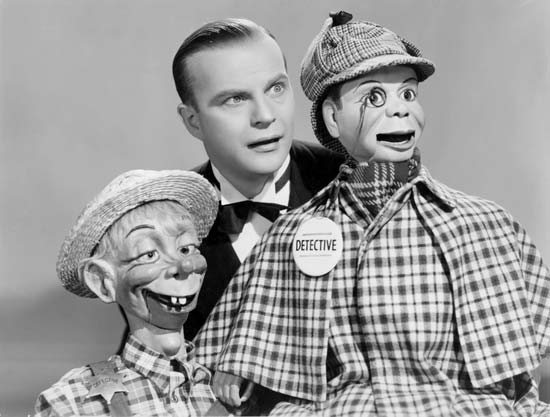A ventriloquist…on the radio?
On this date in 1936, The Royal Gelatin Hour’s Rudy Vallee introduced a very unusual guest:
Why—people have been asking me for the last two days—why put a ventriloquist on the air? The answer is, why not? True, our ventriloquist, Edgar Bergen, is an unusual one—a sort of Noel Coward or perhaps Fred Allen among ventriloquists, a dexterous fellow who depends more upon the cleverness and wit of his material than upon the make-believe of his delivery. Mr. Bergen works with a dummy—several of them, in fact—but this one is a typical ventriloquist’s dummy except that it is arrayed with top hat and tails. Just imagine a dummy and take my word for it that both voices you hear are owned and operated by just one man—Edgar Bergen.
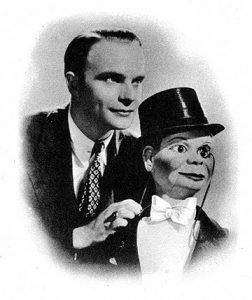 During his boyhood years in Chicago, Edgar John Berggren discovered he had a talent for ventriloquism (often referred to as “belly talk” at that time) …and at first it was just a pastime to fool his family and friends. (One story has him pranking his mother by throwing his voice, convincing her an elderly man was at their front door). He became more and more serious about his talent as he grew older, and was no doubt buoyed after attending a Windy City performance from noted ventriloquist Harry Lester. Lester was so impressed with Bergen (after meeting with young Edgar backstage) that he gave the novice “belly-talker” a couple of lessons free of charge.
During his boyhood years in Chicago, Edgar John Berggren discovered he had a talent for ventriloquism (often referred to as “belly talk” at that time) …and at first it was just a pastime to fool his family and friends. (One story has him pranking his mother by throwing his voice, convincing her an elderly man was at their front door). He became more and more serious about his talent as he grew older, and was no doubt buoyed after attending a Windy City performance from noted ventriloquist Harry Lester. Lester was so impressed with Bergen (after meeting with young Edgar backstage) that he gave the novice “belly-talker” a couple of lessons free of charge.
Bergen’s ventriloquist talent also helped him graduate from high school. As the old joke goes, Edgar’s report cards were soaking wet because his grades were below “C” level…but his teacher, after good-naturedly enjoying a performance her pupil gave at a high school recital (where he needled both her and the principal), helped tutor Bergen so he could order his cap and gown. Edgar also depended on ventriloquism to put himself through college; he was enrolled at Northwestern University as a pre-med student, and entertaining at socials and private functions paid the bills. Eventually, the roar of the greasepaint and smell of the crowd proved too tempting for the young man, and he abandoned med school to pursue a show business career. It was through many years of one-night stands and three-a-days on “the sawdust trail” that allowed Edgar to perfect his craft and achieve the dream of every vaudevillian: playing New York’s Palace Theatre in 1930.
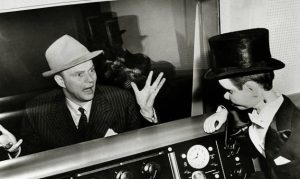 By the time Bergen returned from a tour of both Europe and South America, vaudeville was in hospice. This meant Edgar would have to change the venues in which he worked, and he opted for entertaining in swanky nightclubs. To accommodate this change, he dressed dummy Charlie McCarthy in top-hat-and-tails, and gave Charlie an English accent. Bergen got work at New York’s Helen Morgan Club and Chicago’s Chez Paree, and he soon became a hit at private parties as well. It was at an affair for Noel Coward in 1936—thrown by professional party maven Elsa Maxwell—that Edgar attracted the attention of Rudy Vallee, who agreed to put Edgar and Charlie on his NBC show. (An idea that stupefied the advertising department of J. Walter Thompson, who worked with The Vagabond Lover’s sponsor.) Rudy’s instincts were on the money; Edgar and Charlie went over big with his audience, and were invited back for an additional thirteen weeks.
By the time Bergen returned from a tour of both Europe and South America, vaudeville was in hospice. This meant Edgar would have to change the venues in which he worked, and he opted for entertaining in swanky nightclubs. To accommodate this change, he dressed dummy Charlie McCarthy in top-hat-and-tails, and gave Charlie an English accent. Bergen got work at New York’s Helen Morgan Club and Chicago’s Chez Paree, and he soon became a hit at private parties as well. It was at an affair for Noel Coward in 1936—thrown by professional party maven Elsa Maxwell—that Edgar attracted the attention of Rudy Vallee, who agreed to put Edgar and Charlie on his NBC show. (An idea that stupefied the advertising department of J. Walter Thompson, who worked with The Vagabond Lover’s sponsor.) Rudy’s instincts were on the money; Edgar and Charlie went over big with his audience, and were invited back for an additional thirteen weeks.
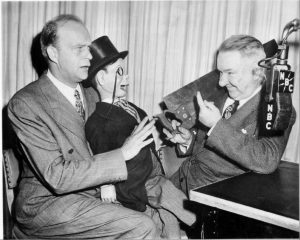 Realizing that Bergen and McCarthy were a hot property, NBC added the duo to the all-star lineup of The Chase and Sanborn Hour when it premiered on May 9, 1937. Though this hour-long variety show would eventually be taken over by Edgar and his wooden companions (Charlie, Mortimer Snerd, Effie Klinker, etc.), it’s interesting to remember that Bergen’s co-stars on the program included Nelson Eddy, Don Ameche, Dorothy Lamour, and W.C. Fields. Fields’ stint on the show lasted only four months, but in that time his “feud” with Charlie McCarthy became every bit as popular as the quarrel between Jack Benny and Fred Allen or the squabble that pitted Walter Winchell against Ben Bernie. (Bergen & McCarthy would even give The Great Man grief in 1939’s You Can’t Cheat an Honest Man, one of Fields’ funniest films.) When the contracts of Ameche, Eddy, and Lamour were up for renewal, the sponsor decided instead to prune the weekly show to a half-hour on Sunday nights. The program still bore the “Chase & Sanborn” moniker…but radio fans simply referred to it as “Charlie McCarthy.”
Realizing that Bergen and McCarthy were a hot property, NBC added the duo to the all-star lineup of The Chase and Sanborn Hour when it premiered on May 9, 1937. Though this hour-long variety show would eventually be taken over by Edgar and his wooden companions (Charlie, Mortimer Snerd, Effie Klinker, etc.), it’s interesting to remember that Bergen’s co-stars on the program included Nelson Eddy, Don Ameche, Dorothy Lamour, and W.C. Fields. Fields’ stint on the show lasted only four months, but in that time his “feud” with Charlie McCarthy became every bit as popular as the quarrel between Jack Benny and Fred Allen or the squabble that pitted Walter Winchell against Ben Bernie. (Bergen & McCarthy would even give The Great Man grief in 1939’s You Can’t Cheat an Honest Man, one of Fields’ funniest films.) When the contracts of Ameche, Eddy, and Lamour were up for renewal, the sponsor decided instead to prune the weekly show to a half-hour on Sunday nights. The program still bore the “Chase & Sanborn” moniker…but radio fans simply referred to it as “Charlie McCarthy.”
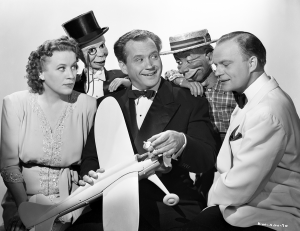 Throughout Radio’s Golden Age, Edgar Bergen’s broadcasts rarely budged from the top five of the medium’s most popular comedy programs (and it was often ranked at #1). It was only in the 1948-49 season that the ratings took a dip, owing to the stiff competition from Stop the Music. Yes, Bergen & McCarthy had the same trouble as Fred Allen…but while Allen stubbornly insisted on staying in his time slot (even bribing viewers with a $5,000 offer if they had been called by Stop the Music while they were listening to his show), Bergen chose to go on hiatus in December of 1948—presciently guessing that the Stop the Music phenomenon would burn itself out. In the fall of 1949, Bergen returned to his proper position in the ratings (with new sponsor Coca-Cola), and pretty much outlasted all of his radio contemporaries. Bergen remained on the air until July 1. 1956, returning in his last two seasons to an hour-long format.
Throughout Radio’s Golden Age, Edgar Bergen’s broadcasts rarely budged from the top five of the medium’s most popular comedy programs (and it was often ranked at #1). It was only in the 1948-49 season that the ratings took a dip, owing to the stiff competition from Stop the Music. Yes, Bergen & McCarthy had the same trouble as Fred Allen…but while Allen stubbornly insisted on staying in his time slot (even bribing viewers with a $5,000 offer if they had been called by Stop the Music while they were listening to his show), Bergen chose to go on hiatus in December of 1948—presciently guessing that the Stop the Music phenomenon would burn itself out. In the fall of 1949, Bergen returned to his proper position in the ratings (with new sponsor Coca-Cola), and pretty much outlasted all of his radio contemporaries. Bergen remained on the air until July 1. 1956, returning in his last two seasons to an hour-long format.
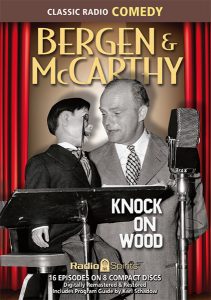 Radio Spirits invites you to enjoy Edgar Bergen & Charlie McCarthy’s later radio years with two fine collections: The Funny Fifties (which features several rare radio broadcasts) and The New Edgar Bergen Hour (also spotlighting rare shows). Our most recent Bergen & McCarthy release, Knock on Wood, also has recently unearthed broadcasts (from 1942) as does Smile a While (with rare 1943 broadcasts…and liner notes from yours truly). One of my favorite Radio Spirits collections is W.C. Fields and Friends, which features the duo squaring off against a true comedic great (according to Don Ameche, W.C. was not a member of Charlie’s fan club despite his admiration for Edgar’s talents). Finally, for those of you who’d like to recover from these sumptuous servings of Edgar & Charlie, you can sample nibbles of the team on Jack Benny & Friends, Great Radio Comedy, Comedy Goes West, Christmas Radio Classics, and the DVD set Funniest Moments of Comedy.
Radio Spirits invites you to enjoy Edgar Bergen & Charlie McCarthy’s later radio years with two fine collections: The Funny Fifties (which features several rare radio broadcasts) and The New Edgar Bergen Hour (also spotlighting rare shows). Our most recent Bergen & McCarthy release, Knock on Wood, also has recently unearthed broadcasts (from 1942) as does Smile a While (with rare 1943 broadcasts…and liner notes from yours truly). One of my favorite Radio Spirits collections is W.C. Fields and Friends, which features the duo squaring off against a true comedic great (according to Don Ameche, W.C. was not a member of Charlie’s fan club despite his admiration for Edgar’s talents). Finally, for those of you who’d like to recover from these sumptuous servings of Edgar & Charlie, you can sample nibbles of the team on Jack Benny & Friends, Great Radio Comedy, Comedy Goes West, Christmas Radio Classics, and the DVD set Funniest Moments of Comedy.

